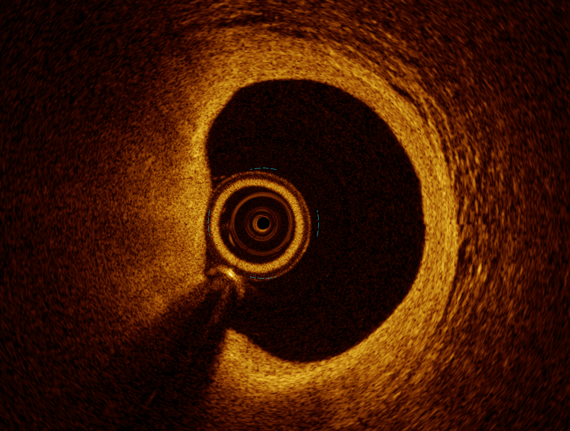Identifying high risk coronary lesions using Optical Coherence Tomography
The PECTUS-obs trial aims to identify coronary artery lesions that are at high risk of causing a future heart attack, also known as myocardial infarction (MI). With the help of both private and public funds, the hope is to distinguish ‘safe’ lesions from ‘vulnerable’ lesions by looking at the internal structure of a plaque. To make this distinction, a novel imaging technique called ‘Optical Coherence Tomography’ (OCT) is used.
Patients that present to the hospital with MI are normally treated with a cardiac catheterization with angioplasty of the lesion that caused the event, known as the ‘culprit lesion’. Despite this adequate initial treatment, large registries of patients who present with MI show that more than 18% develop one or more subsequent MI’s within the following five years [1]. Therefore, it is evident that there is still a lot to be gained in the prevention of new cardiac events following an MI. A possibility for the prevention of future events might lie in the characterization of other (‘non-culprit’) lesions in other parts of the coronary arteries, which are often seen in MI patients as ‘innocent bystanders’. At this moment, these lesions might either be treated in addition to the culprit lesion, or left alone, depending on how much these lesions hamper blood flow.
Earlier small studies have suggested that lesions that cause myocardial infarctions differ structurally from those that do not. With the development of OCT, there is a technology with the required resolution to visualize these structures in real life patients. In the PECTUS-obs trial patients with MI will undergo OCT imaging of any non-obstructive non-culprit lesions they might have. After a five-year follow-up period it will be determined if OCT was indeed able to distinguish ‘vulnerable’ from ‘safe’ lesions.
Based on the results of this trial, earlier intervention with either local or systemic therapies could become a possibility in the future. This might lead to prevention of myocardial infarction and a significant reduction morbidity and mortality.



